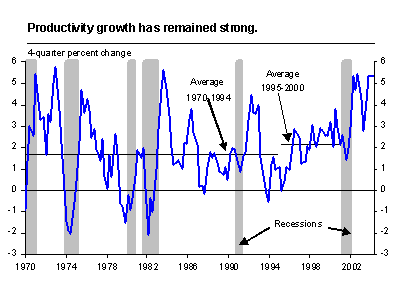1. The U.S. recovery has gathered considerable momentum since last year, again leading the global recovery. The economy has weathered an unprecedented series of adverse shocks—including the collapse of the IT-bubble, terrorist attacks, geopolitical uncertainties, and weaknesses in corporate governance—and has been expanding strongly since mid-2003. Encouragingly, the upturn reflects continuing exceptional U.S. productivity growth, in addition to the sizable injection of monetary and fiscal stimulus.
2. Most indicators point to a robust expansion in 2004 and give confidence that the United States will continue to act as the key engine for global growth, especially in the context of relative weakness of demand abroad. Support from household and government spending is projected to ease in the coming year as the effects of policy stimulus wane. However, corporate sector profitability and cash flow have rebounded strongly, business investment is picking up, and net exports are expected to benefit from the dollar's recent depreciation. Some downside risks remain, including from the geopolitical situation and its implications for energy prices. Moreover, there remains the possibility of a more abrupt slowdown of household demand given the low household saving rate, relatively sluggish employment growth, and concerns regarding overvaluation in some real estate markets and large consumer debt loads. However, these risks appear balanced by the possibility of further upside surprises to the economy's supply side.
3. With the improved near-term outlook, the coming year provides an important opportunity for withdrawing policy stimulus and putting in place the conditions needed for a durable and sustained expansion:
• Fiscal sustainability. The key challenge is to entrench a lasting framework for restoring fiscal surpluses and paying down federal debt ahead of the retirement of the baby-boom generation while moving rapidly on entitlement reform. Such an objective would anchor an improvement in national saving and avoid U.S. fiscal deficits crowding out investment at home and abroad.
• An orderly withdrawal of monetary stimulus. The ongoing recovery creates room to begin adjusting interest rates to more neutral levels, and the Federal Reserve has already prepared the ground for the withdrawal of stimulus.
• Leadership on trade and financial sector policies. With multilateral trade talks at a critical juncture, and weaknesses in corporate governance continuing to be a concern domestically and abroad, the United States has an important opportunity to continue its leadership role in these areas.
Fiscal policy
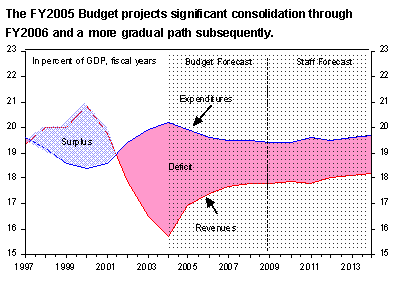
4. The FY2005 budget has signaled a welcome shift toward fiscal consolidation in the coming two years. Although the recent stimulus has provided valuable support to the economy, with the recovery now well on track, the deficit reduction assumed for FY2005 and FY2006—roughly 2 percentage points of GDP—is appropriate. Encouragingly, there are also signs that the FY2004 deficit could be smaller than originally estimated. However, fiscal prospects in the next two years remain subject to important uncertainties-including with regard to ongoing operations in Iraq and Afghanistan and the budgetary cost of a number of legislative initiatives presently before Congress. The challenge will be to contain such pressures and to ensure that the better-than-expected results this year are used to strengthen subsequent deficit-reduction objectives.
5. A similarly ambitious rate of deficit reduction beyond the next two years would help place the long-run fiscal position on a more sustainable basis. Recent budget documents have highlighted that federal deficits and debt will start to rise over time as the baby-boom generation begins to retire and place increased demands on entitlements. Indeed, the long-term fiscal imbalance has widened in recent years as a result of tax cuts and the expansion of Medicare benefits. Therefore, the deficit reduction that is currently envisaged after FY2006 appears modest and may also be challenging, since it assumes success in lowering nondefense discretionary spending as a share of GDP to its lowest level since the 1960s and a sharp increase in taxpayer liabilities under the Alternative Minimum Tax.
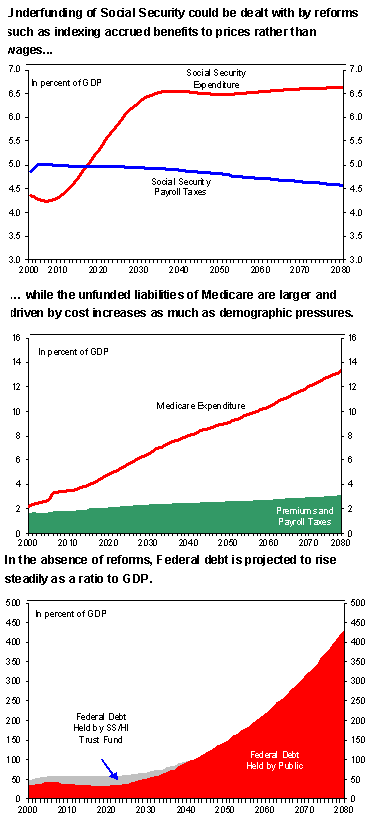
6. Against this background, we continue to recommend aiming for a balanced budget, excluding Social Security, say by the end of the decade. While entitlement reform holds the key to long-run fiscal sustainability, based on past experience it can take a long time to design and phase in measures that would place such programs on a sound financial footing. Restoring a fiscal surplus equal to the cash-flow surplus of the Social Security system by the end of the decade would allow U.S. federal debt to be paid down ahead of the retirement of the baby-boom generation, and provide greater fiscal room to build consensus around and implement entitlement reforms. Moreover, staff analysis suggests that reducing the budget deficit by 1 percentage point of GDP annually through the rest of this decade—roughly the rate envisioned for FY2005-06—could provide significant supply-side benefits to the United States and elsewhere by reducing pressures on global interest rates and investment, with only modest effects on short-term activity.
7. The recovery provides a valuable opportunity for embarking upon the fiscal effort that is needed to achieve such a medium-term objective. The Administration has supported re-authorizing a strengthened version of the Budget Enforcement Act (BEA), which could provide the necessary framework for solidifying fiscal responsibility and expenditure discipline. However, the proposal to exclude most revenue measures from the coverage of the pay-as-you-go requirement and to shorten its horizon to five years would weaken the legislation's discipline. As for the measures needed to achieve consolidation, curtailing expenditures will undoubtedly be an essential element, especially given the rapid growth of outlays in recent years, and curbing business and agricultural subsidies could help boost the economy's supply side. Nonetheless, given the magnitude of the fiscal adjustment required and already ambitious plans for cutting nondefense discretionary spending, revenue enhancements should not be ruled out. To avoid having to unwind recent marginal tax rate cuts and give up their potential supply-side benefits, emphasis should be laid on reforms to broaden and simplify the tax base, such as by cutting tax expenditures, which are significant and distort resource allocation.
8. Delaying measures to address the Social Security system's funding problems will entail larger and more painful adjustments later on. The Administration has already taken the important step of commissioning reform proposals, and the 2004 Economic Report of the President illustrates that amending indexation formulas would slow benefit growth and eliminate the system's underfunding. It also shows that diverting a portion of the payroll tax into private retirement accounts would have the effect of significantly boosting the federal budget deficit and the debt/GDP ratio over the next 45 years, illustrating the importance of coupling this measure with durable steps to address long-term fiscal sustainability. These concerns aside, the key priority remains to translate this analysis into concrete reform proposals.
9. The financial problems of the Medicare system dwarf those of Social Security, and have increased as a result of the additional drug benefits introduced last year. The Medicare Reform legislation included useful initiatives to introduce competition and increase efficiency in health care delivery, and the means-testing of Part B premiums could enable enhancements of system revenues. However, the Medicare system is still expected to begin running cash-flow deficits by the end of the next decade and outlays are projected to triple as a share of GDP by mid-century. Although demographic pressures are a significant factor behind this deterioration, cost increases associated with technological advances are equally important. This suggests that durable solutions to the Medicare problem may also require broader, efficiency-enhancing reforms of the U.S. health care system.
Monetary policy and the exchange rate
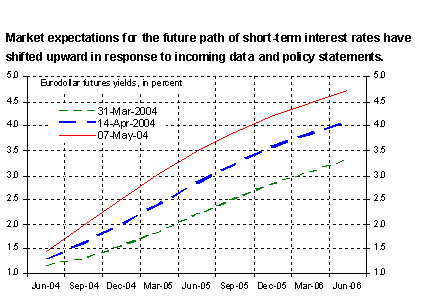
10. The Federal Open Market Committee (FOMC) has appropriately begun preparing markets for the gradual withdrawal of stimulus. The aggressive easing of recent years has provided essential support to the recovery, and the Federal Reserve is to be commended for forestalling fears of deflation that emerged last year. However, the recent signs that the recovery is maturing, labor market conditions are improving, and concerns that higher energy prices could revive inflation expectations, suggest that the time has come to start removing stimulus. Against this background, the FOMC's May 4 statement appropriately signaled a shift in policy bias, while recognizing the scope for a measured withdrawal of stimulus. In light of the usual transmission lags for monetary policy and the fact that the current federal funds rate is well below levels consistent with a neutral stance, it is encouraging that the FOMC's statement has helped market participants recognize the need for an earlier withdrawal of monetary stimulus.
11. By any standards, the Federal Reserve is highly transparent. It remains an open issue, however, whether still further information on the Federal Reserve's analysis and intentions would improve the effectiveness of monetary policy. We welcome, therefore, the FOMC's January 2004 discussion of the possible benefits of more systematic statements of the balance of risks and policy intentions, of accelerating the publication of FOMC minutes, and of providing greater detail of the FOMC's macroeconomic forecasts. From a broader perspective, the Federal Reserve could further anchor expectations by clarifying its definition of price stability and its medium-term inflation objective.
12. Financial markets have demonstrated during the past year their ability to digest significant exchange rate movements. Nonetheless, the U.S. current account deficit is still expected to remain large at 5 percent of GDP, dependent upon foreign private and official investor appetite for net claims against U.S. residents, with the attendant risk that shifts in such demand could result in more abrupt adjustments of interest and exchange rates. To be sure, a smooth resolution of global current account imbalances must involve stronger growth abroad. However, determined efforts to strengthen the U.S. fiscal position would raise national saving and help ensure that the inevitable adjustment is orderly and does not place an undue burden on investment, both domestically and abroad.
Financial sector and corporate governance
13. The banking sector has proven its resilience over recent years and ongoing reforms of corporate governance have increased confidence in market integrity. Indeed, high levels of bank capital, improvements in credit quality, and strong risk management appear to have left the financial system well prepared for the expected withdrawal of monetary stimulus. The authorities have also moved effectively to implement the Sarbanes-Oxley legislation to strengthen corporate governance, including registration of the accounting profession through the new Public Company Accounting Oversight Board. Looking ahead, it will be important to ensure that the Financial Standards Accounting Board is able to fulfill its responsibilities in an independent manner, while recent revelations with respect to the mutual fund industry also suggest the need for continued vigilance with regard to financial market practices.
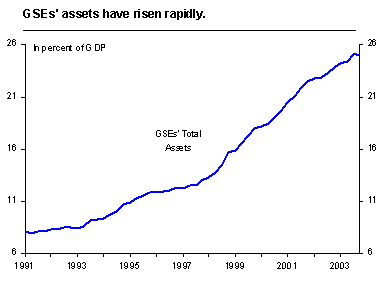
14. The Administration has raised justifiable concerns regarding the large and increasing share of mortgage-backed securities held by the main government sponsored enterprises (GSEs). The growth of these institutions has concentrated interest rate and mortgage prepayment risk, and the Administration's proposal to overhaul the current supervisory regime and establish an independent regulator with powers to set capital requirements and put a GSE into receivership, if needed, warrants legislative support.
Trade policy and overseas development assistance
15. The U.S. authorities have taken welcome steps to provide impetus to the Doha Round negotiations following the breakdown in talks in Cancun. Continued U.S. leadership and commitment to multilateral approaches to trade liberalization, especially with regard to agriculture, will be critical to the success of the Round. In this regard, legislative action to abide by WTO rulings, including with regard to the Foreign Sales Corporation export subsidy, would help demonstrate the continued U.S. commitment to the WTO. The mission also urges U.S. policymakers to extend the third-country fabric provision of the African Growth and Opportunity Act, which expires shortly, in order to avoid an unwelcome disruption to the trade of participating countries.
16. Recent increases in U.S. official development assistance (ODA) and progress on Millennium Challenge Account are welcome. However, U.S. ODA remains the lowest among industrial countries as a share of GDP and the mission urges continued efforts to boost U.S. foreign assistance.








